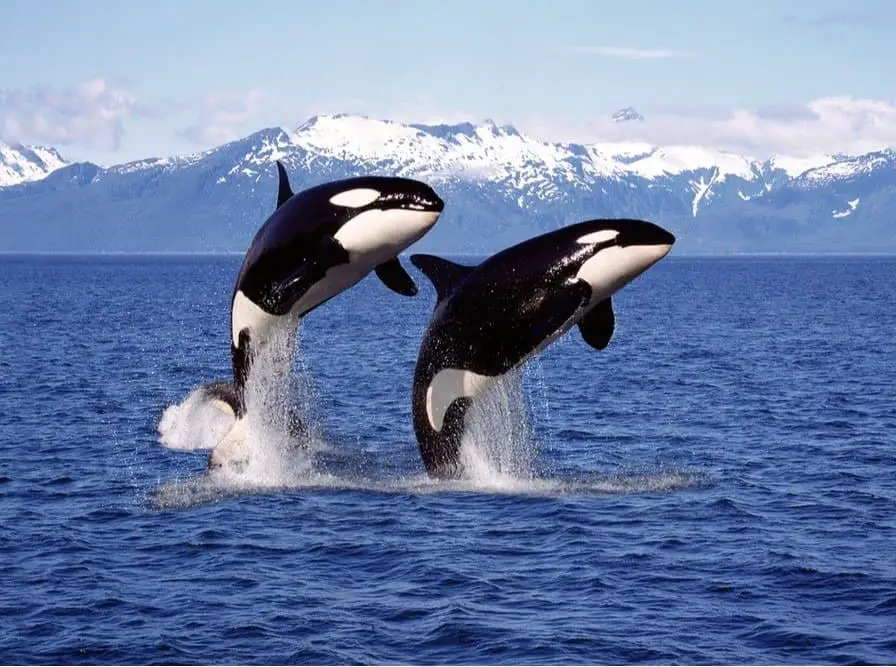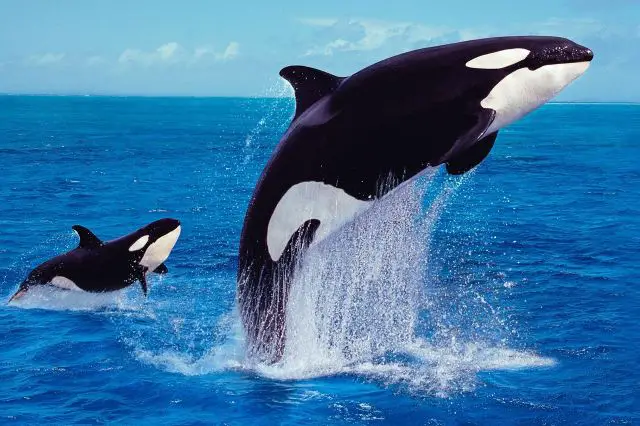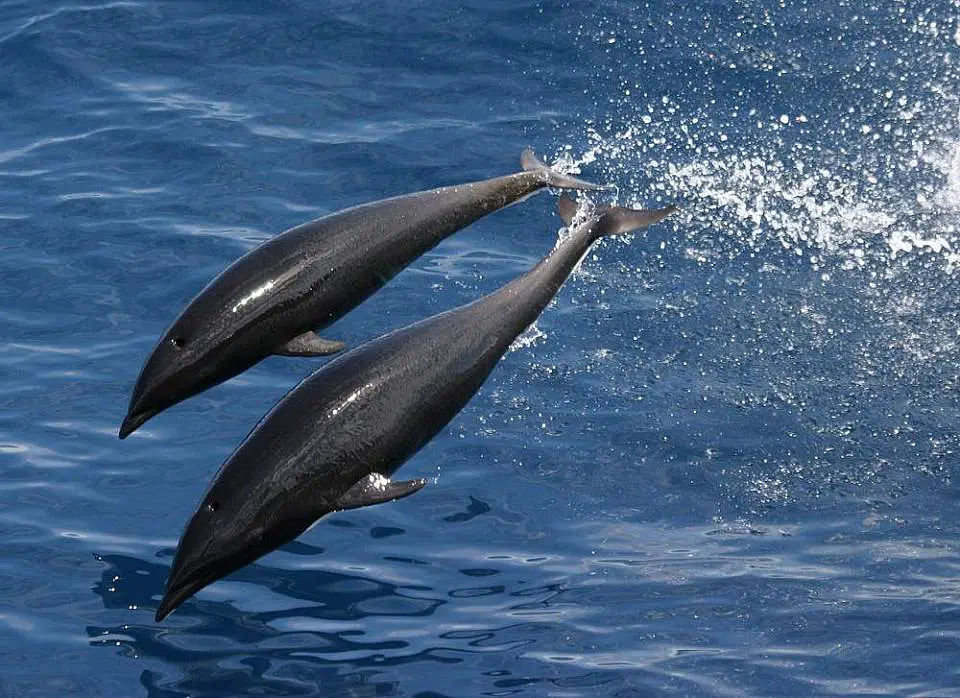What Is The Difference Between A Whale And A Dolphin

Introduction
In the vast and mysterious realm of Earth’s oceans, whales and dolphins reign as some of the most captivating and awe-inspiring creatures. These marine mammals, with their remarkable intelligence and often majestic presence, have enthralled humans for centuries. Yet, as we gaze upon these magnificent beings, a fundamental question often arises: What is the difference between a whale and a dolphin? While the terms “whale” and “dolphin” are sometimes used interchangeably in everyday language, they represent distinct branches of the same evolutionary family tree, each with its own unique characteristics and adaptations.
This exploration takes us on a deep dive into the world of cetaceans, a group of marine mammals that encompasses both whales and dolphins. While these creatures share common ancestry and many physical traits, they also exhibit key differences in size, behavior, and ecological roles.

Are dolphins whales yes or no?
First thing’s first: all dolphins are whales, but not all whales are dolphins. That’s because the Cetacean order of sea animals encompasses dolphins, porpoises and what we think of as whales. And Cetacean is derived from the Greek word for whale, ketos. Yes, dolphins are a type of whale. More specifically, dolphins belong to the family Delphinidae, which is a group of toothed whales. This family includes various dolphin species as well as species commonly referred to as “porpoises.”
All dolphins are cetaceans, a group of marine mammals that includes both toothed whales (like dolphins) and baleen whales. The distinction between toothed whales and baleen whales is primarily based on their dental structures and feeding habits.
Toothed whales, including dolphins, have teeth and typically feed on fish and other marine organisms. They use echolocation to locate and capture prey.
Baleen whales, on the other hand, lack teeth and have baleen plates in their mouths, which they use to filter small organisms like krill from the water. Examples of baleen whales include humpback whales and blue whales.
So, while dolphins are a type of whale, they are specifically classified as toothed whales within the larger cetacean group.
Which is bigger whale or dolphin?
The average dolphin can reach a weight of 660lbs and grows about 13ft long, but the orca can reach lengths of 26ft and a weight of 19,000lbs. All these dolphins pale in comparison to the largest whale of all, the blue whale. This creature can weigh up to 352,000lbs and measure about 100ft at its largest.
In general, whales are larger than dolphins. Whales come in a wide range of sizes, with some of the largest animals on Earth being whales. For example, the blue whale is the largest animal to have ever existed, reaching lengths of up to 100 feet (30 meters) or more and weighing as much as 200 tons.
Dolphins, on the other hand, are smaller in comparison. The size of dolphins varies depending on the species, but they are typically much smaller than most whale species. For instance, common bottlenose dolphins, one of the most well-known dolphin species, can reach lengths of about 10 to 14 feet (3 to 4 meters) and weigh between 600 and 1,200 pounds (270 to 545 kilograms).
It’s important to note that there is considerable size variation among both whales and dolphins, with some dolphin species being larger than others. However, even the largest dolphins are generally smaller than the largest whale species.
What is the difference between whales and dolphins and sharks?
Dolphins, whales, seals, sea lions, and otters are all mammals. They give birth to live young and nurse their young with milk. In contrast, even though some sharks give birth to live young, sharks are fish. Whales, dolphins, and sharks are all marine animals, but they belong to different taxonomic groups and have distinct characteristics:
Taxonomy:
- Whales and dolphins are both members of the order Cetacea, which includes all cetaceans, a group of marine mammals.
- Sharks belong to the class Chondrichthyes, which includes cartilaginous fish, meaning their skeletons are made of cartilage rather than bone.
Skeletal Structure:
- Whales and dolphins are mammals and have skeletons made of bone. They are warm-blooded, give birth to live young, and breathe air.
- Sharks are fish and have skeletons made of cartilage. They are cold-blooded, lay eggs (in most cases), and extract oxygen from water through gills.
Reproduction:
- Whales and dolphins are viviparous, meaning they give birth to live offspring.
- Sharks can be oviparous (laying eggs) or viviparous, depending on the species.
Respiration:
- Whales and dolphins are air-breathing mammals. They have blowholes on top of their heads, which they use to breathe at the water’s surface.
- Sharks respire through gills, extracting oxygen from water.
Teeth:
- Whales and dolphins are toothed whales and have teeth. Their teeth are used for grasping and tearing prey.
- Sharks also have teeth, which vary in shape and function depending on the species. Shark teeth are adapted for cutting, tearing, and crushing prey.
Diet:
- Whales and dolphins are primarily carnivorous, feeding on fish, squid, and other marine creatures.
- Sharks are also carnivorous and have a varied diet that can include fish, seals, other marine mammals, and even smaller sharks, depending on the species.
What is the size difference between a whale and a dolphin?
Whales tend to be between 11 and 110 feet long; dolphins are between 4 and 35 feet long. Some classification systems consider anything over 9 feet as a whale, which can lead to confusion. The size difference between whales and dolphins is significant, with whales generally being much larger than dolphins. Both whales and dolphins encompass a variety of species, each with its own size range. However the contrast in size between the largest whales and the largest dolphins is particularly noteworthy.
Whales:
Largest Whales: Some whale species are among the largest animals to have ever existed on Earth. For example, the blue whale, the largest known animal, can reach lengths of up to 100 feet (30 meters) or more and weigh as much as 200 tons.
Size Range: Whale sizes vary greatly depending on the species. Smaller whale species, like the dwarf sperm whale, may be less than 10 feet (3 meters) long, while larger species, like the humpback whale, can range from 40 to 60 feet (12 to 18 meters).
Dolphins:
Largest Dolphins: The largest dolphin species is the orca, also known as the killer whale. Adult male orcas can reach lengths of up to 32 feet (9.8 meters) and weigh as much as 22,000 pounds (10,000 kilograms).
Size Range: Dolphin sizes also vary among different species. For example, the common bottlenose dolphin, one of the most well-known dolphin species, typically measures between 10 and 14 feet (3 to 4 meters) in length and weighs between 600 and 1,200 pounds (270 to 545 kilograms).
Are whales friendly?
Historical research paints a much different picture, but today, modern research shows us that whales are and always have been typically a friendly species. Today when whales are spotted, their relationships with humans are now amicable, social, and inquisitive. Whales, as a group, do not exhibit consistent behaviors that can be universally described as “friendly” or “unfriendly.” Instead, their behavior is influenced by a variety of factors, including their species, individual temperament, environmental conditions, and interactions with humans or other animals.
Some points to consider regarding the behavior of whales:
Species Variation: Different whale species exhibit different behaviors. Some species are more solitary, while others are highly social and may interact with other animals, including humans, in a friendly manner.
Social Whales: Species like orcas (killer whales), beluga whales, and some dolphin species are known for their social and playful behavior, and they may be more inclined to interact with humans in a friendly manner when encountered in the wild.
Wild vs. Captive Whales: The behavior of whales in captivity may differ from that of wild whales. Some captive whales have been trained to interact with humans and perform tricks, which can create a perception of friendliness.
Respect for Wild Animals: In encounters with wild whales, it is crucial to approach with caution and respect for their space and natural behavior. Interactions should be non-intrusive and follow guidelines to ensure the safety of both humans and the whales.
In general, while some whale species and individuals may display curious or friendly behavior toward humans, it is essential to remember that they are wild animals, and their behavior can be unpredictable. Interactions with wild whales should prioritize their well-being and respect their natural behaviors and habitats.
How do whales sleep?
Instead, they have a fascinating adaptation known as ‘unihemispheric sleep’. To be able to sleep, whales shut down half of their brain at a time. Being partially awake allows them to continue breathing and be aware of their surroundings. Whales will usually stay in place as they sleep near the surface. Whales have a unique way of sleeping that differs from terrestrial mammals. They are conscious breathers, which means they need to come to the water’s surface to breathe. Consequently, they cannot enter a deep, unconscious sleep like humans or many other animals.
Instead, whales experience periods of rest that involve shutting down one hemisphere of their brain at a time, allowing the other hemisphere to remain active for essential functions like swimming and surfacing to breathe. This form of sleep is called “unihemispheric slow-wave sleep” or “asynchronous sleep.”
Here’s how it works:
Half-Brain Rest: While resting, one half of the whale’s brain enters a state of slow-wave sleep, during which it experiences reduced activity and awareness. This allows the whale to rest that hemisphere of the brain.
Active Hemisphere: The other half of the brain remains active during this time, ensuring that the whale continues to swim, rise to the surface to breathe, and stay alert to potential threats.
Alternating Hemispheres: Whales alternate between hemispheres of the brain in this manner. The duration of these rest periods and the switching between hemispheres can vary among species and individuals.
This adaptation allows whales to get the rest they need while maintaining essential functions like respiration and maintaining awareness of their surroundings. It also enables them to respond to potential dangers in their marine environment.
It’s important to note that the sleep patterns of whales, particularly the duration and frequency of rest periods, can vary among species. Some species may engage in more frequent short rests, while others may have longer and less frequent rest periods. These adaptations help whales survive in their oceanic environment while meeting their physiological needs.
Is it safe to touch a whale?
Even though you might get close to the whales, never try touching them. Some reasons why you shouldn’t try touching a whale include: You might get hurt or sick. Whales may scratch, bite, or thrash their tails, placing you in danger. Touching a whale in the wild is generally discouraged and, in many cases, illegal in many countries due to several important reasons:
Protection of Wildlife: Approaching and touching wild whales can disrupt their natural behaviors and stress them. It’s essential to protect the well-being of these animals and maintain their natural habitat.
Human Safety: Whales are powerful and massive creatures. Approaching them in the wild and attempting to touch them can be dangerous for humans. Whales might react unpredictably, potentially causing harm to people or boats.
Legal Regulations: Many countries and regions have strict regulations and laws that prohibit the harassment, disturbance, or touching of marine mammals, including whales. Violating these regulations can result in hefty fines and penalties.
Ethical Concerns: Ethically, it’s important to prioritize the welfare of wild animals over personal interactions or experiences. Touching or approaching whales in the wild can be stressful for them and disrupt their natural behaviors.
Conservation Efforts: Engaging in responsible wildlife viewing practices, such as whale-watching tours led by trained guides, supports conservation efforts and educates people about these magnificent creatures without causing harm.
If you’re interested in observing or learning about whales, consider participating in a responsible whale-watching tour led by experts who are knowledgeable about marine mammal behavior and conservation. These tours often adhere to strict guidelines to minimize disturbance to the animals while providing educational opportunities for the public.
Do whales ever stop swimming?
The ability of different species of cetaceans to hold their breath varies between a few minutes and over an hour. Their sleeping habits are also non-standard. Humpback whales, for example, have been found resting motionless on the surface of the water for about 30 minutes. Whales are continuous swimmers, but they do not swim ceaselessly throughout their entire lives. Instead, they have a pattern of swimming, resting, and sleeping that is adapted to their unique needs as marine mammals:
Unihemispheric Sleep: Whales cannot enter a deep, unconscious sleep like humans because they are conscious breathers and need to surface for air. Instead, they engage in unihemispheric slow-wave sleep. This means they rest one hemisphere of their brain at a time while the other hemisphere remains active for essential functions like swimming and surfacing to breathe. This adaptation allows them to rest while maintaining alertness.
Resting Patterns: Whales often rest by reducing their activity and slowing their swimming. During these rest periods, they may maintain buoyancy in the water column, which requires less effort than continuous active swimming. The duration and frequency of rest periods can vary among species and individuals.
Migration and Feeding: Whales are known for their long migrations, which involve periods of active swimming. During these migrations, they travel significant distances to find food or reach breeding grounds.
Feeding and Foraging: When whales are actively feeding and foraging for prey, they can engage in intensive swimming and diving as they pursue schools of fish or other prey species.

Conclusion
In the vast expanse of the world’s oceans, where mysteries abound and life flourishes in myriad forms, the distinction between whales and dolphins serves as a reminder of the rich tapestry of marine life that calls these waters home. While these creatures share a common evolutionary heritage as cetaceans, they have embarked on divergent paths in terms of size, behavior, and ecological roles.
As we conclude our exploration of the differences between whales and dolphins, we gain a deeper appreciation for the intricacies of the natural world and the remarkable diversity of life within Earth’s oceans. These creatures, whether colossal whales or playful dolphins, are emblematic of the wonders and mysteries that continue to captivate our imaginations and fuel our scientific curiosity.



